
 |
Roisin and I had just arrived back home in Cookstown during the late evening after a very successful thunderstorm intercept in Co. Armagh. We had spent a long day walking and driving in the heat (25.6C) and were ready to settle down and relax for the rest of the night. I quickly began charging the batteries on both DSLRs, uploaded the images to the lap top then formatted the memory cards, I was preparing the gear and myself for what I hoped would be an NLC display this same night. After a succession of cloudy nights tonight was forecast to be clear and before sunset the sky was perfectly blue and cloudless, the forecast looked to be living up to expectations. I was on a naturall high from experiencing close range thunder and lightning earlier and I did say to Roisin imagine there was an NLC display tonight, that would make for the perfect day.
At 22.45 I did a check through social media, I saw a post from Will Gater from BBC Sky At Night reporting NLCs, soon a few other reports appeared too, however none of them mentioned anything about structure or brightness or if it was even a good display or not, I suspected if it was decent they would have said so so I decided to wait a while before heading out, I honestly would be happy to get any NLCs at all after a storm day, that conjured up great memories from 2009 and other years when we seemed to get far more thunderstorms by day and great NLC spectacles by night, those were action packed Summers with little room for sleep, if tonight could produce then it would fall into the caliber of those special memories.
At 23.00 my phone began to ring, it was Jonathan Bingham, chair person of NIAAS and also a keen NLC observer, he said ''are you seeing what I'm seeing?''. I admitted I hadn't, in fact, I hadn't even looked at the sky outside yet as it was still bright, he asked me to take a look to the west because there was no mistake about what he was looking at. I looked out from an upstairs window and saw what he was seeing, no question about it, a long strip of thick white NLCs crossed the high western sky, I immediately got excited, if they were that high and and easy to see against such a bright twilight sky then they had to be a serious display which would reveal itself within the next hour as the sky got darker. I thanked Jonathan for the call and tip off and he said he would chat later and wished me luck.
I immediately changed into my boots, grabbed a light denim jacket, camera gear, then raced out the door. I had an instinct this was going to be a good show and I needed to be at a good location to get shooting, I also was keen to get a decent NLC time lapse. To be honest with you this has been my personal worse NLC season to date, we have been clouded out for the majority of the season, I had only witnessed two displays prior to this, one of which was rubbish and faded away, the first was a large bright display which I captured from Beaghmore Stone Circles on the night of the Solstice, a great night, but I wasn't that impressed with the display, it lacked the structure which got me buzzing, so I was still waiting for that special display, the kind which happens only once or twice a season. For me the best displays are not necessarily the biggest and brightest, in fact, the most photogenic and visually impressive displays happen when the NLCs lower in height and remain visible all night long against the darker sky background, when this happens they tend to have an unearthly glow with stars above and because of their oblige viewing angle the cloud forms tend to overlap creating remarkable structures, these have always been my favourite displays, I hoped that this one display tonight would make my season.
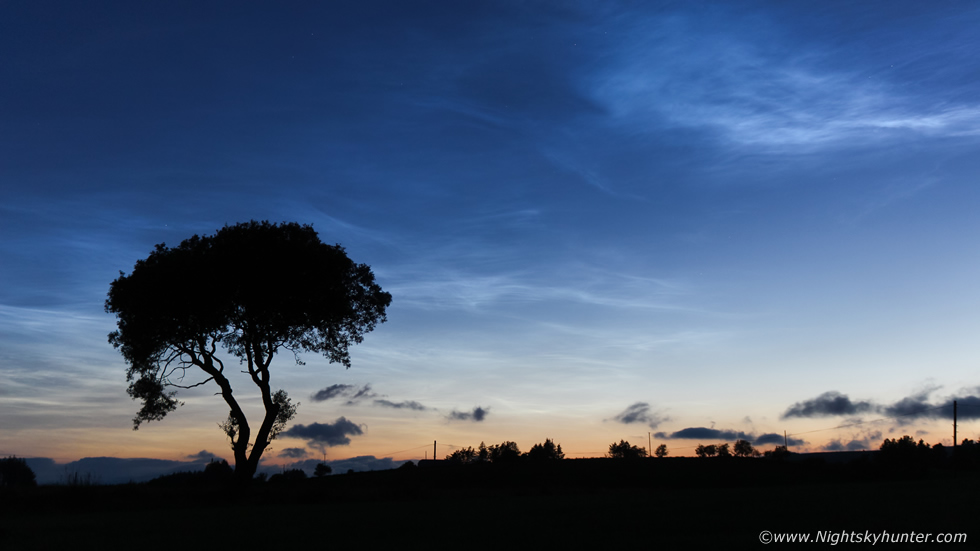 |
On an instinct I drove straight to Beaghmore, I didn't think much about it so I just went with the flow. During the drive along the Omagh Road the view of the twilight sky was gorgeous, through the windscreen the sky was full of NLCs covering the entire west and north west sky to 55 degrees (110 full moon diameters) high, they were type 4 brightness with long bands and waves glowing silver and electric blue all the way down to the horizon and near the north west almost touching the Sperrins was a golden crescent Moon setting over the dark outline of the hills at Broughderg, it was a truly gorgeous sight.
I quickly decided to try what I called the fairy tree which Roisin and I had found over a year ago during a random drive, actually it was Roisin who discovered it and suggested it would be good for shooting at night and I've never forgotten about it. I shot the Milky Way over it last August but had kept it in mind for NLCs so tonight would be the night. I parked on a grass verge and climbed over a gate carrying two camera bags and two tripods, I stopped for a moment to adjust to the ambient light and to make sure no cattle where in the field, there were none, so I advanced across the field to the tree. Within a couple of minutes I had two cameras shooting time lapse, 18mm and 15mm. The display had already lowered in height as the sun dropped below the horizon, this was the view with the 18mm lens facing west.
I sent out a few text messages to tip off others just in case they hadn't seen it, Nigel McFarland, John Fagan, Paul Martin, John C. McConnell. The NLCs in the west were rapidly dropping in height and fading and were mostly in the form of glowing IIa bands and veil, they were diminishing fast, was this going to be another one of those nights when NLCs randomly vanished yet again?, then I casually glanced to the north, there was another NLC display forming, in fact, it was growing rapidly in the N, NW and even E of N, it had all the hall marks of turning into the kind of display I had hoped for, now all my attention was focused on these new developments.
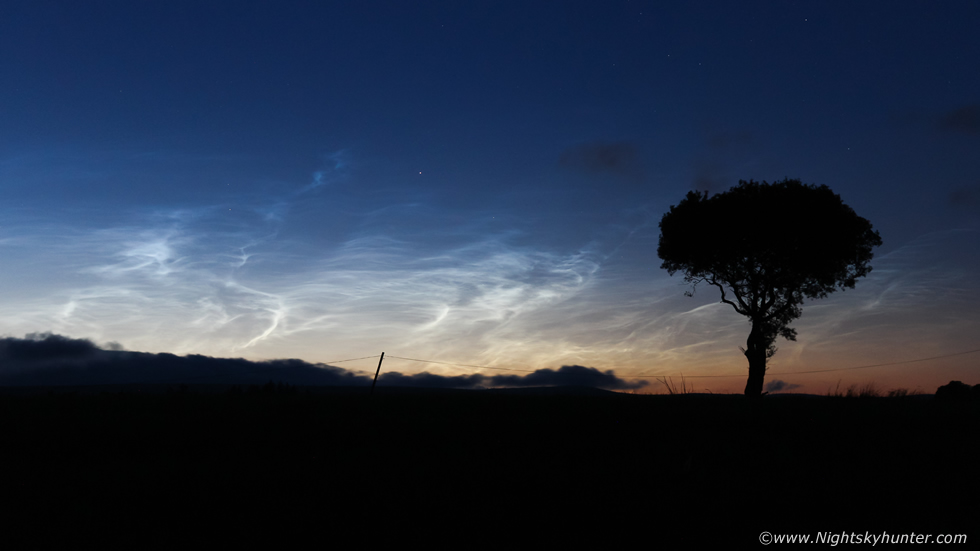 |
As the sky darkened the NLCs came to life, they prospered and thrived and evolved into very complex structures, by midnight they were absolutely beautiful. My head torch refused to work tonight so the field in which I stood was pitch black, the NLCs were glowing at type 4 and were bright enough to hamper dark adaption just by looking at them. In the dark I had to slowly make my way across the field with camera, cross a ditch with big rocks hidden in the grass then make my way into another large field, this one gave me a good angle on the NLCs and fairy tree. I settled in and began shooting time lapse, my phone rang again, it was Jonathan, we watched the display together while chatting about the various aspects of the NLCs.
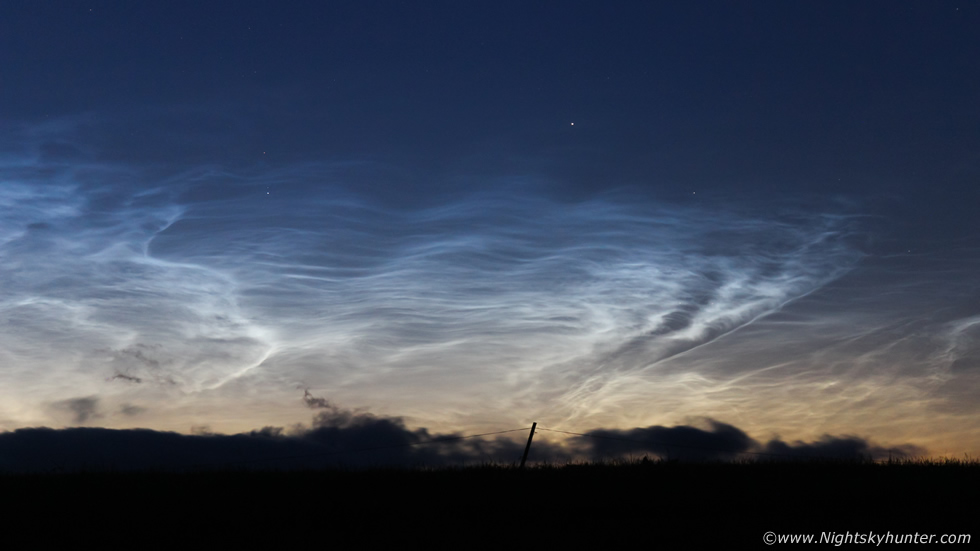 |
The sky was getting darker by the minute and the NLCs seemed to take on an alien glow, check out the those large scale whirls, waves/herringbone with undulations and lacunosus holes to the right.
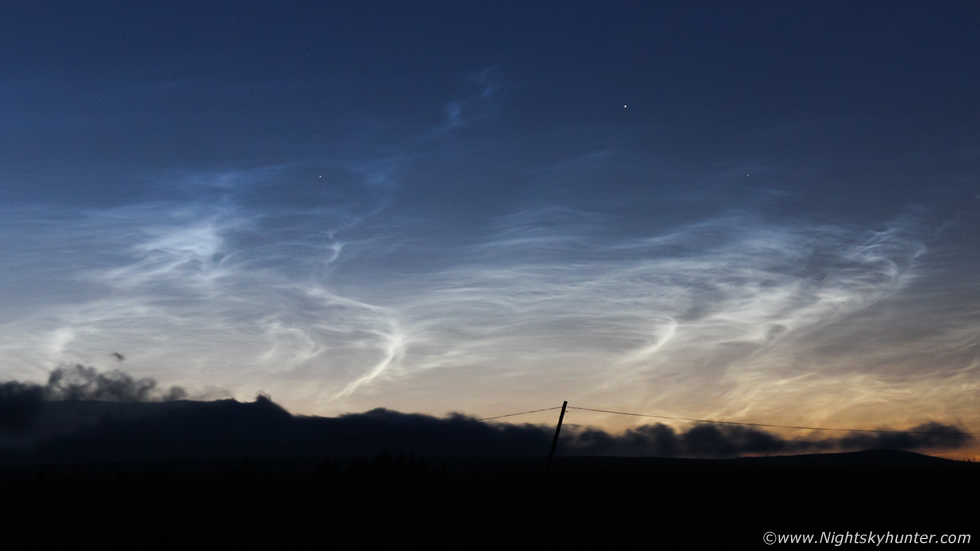 |
The display had the classic electric blue and silver colours but was also complimented by gold and orange hues closer to the horizon due to atmospheric effects. Check out the complex array of whirls forming loops to the left while on the right the waves look like ice particles being streaked across the Mesosphere by high altitude winds. You can see dark clouds over the summit of the mountain, there were reports of people getting clouded out and fogged out to the north east and with the NEly flow I reckoned it was heading this way so I was determined to make the most of this show before it filled in for the night.
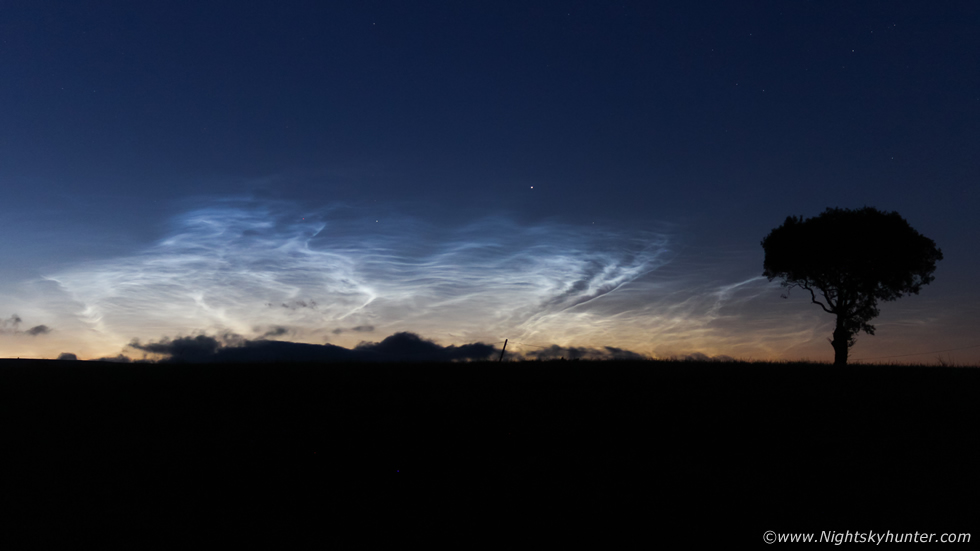 |
It never filled in, in fact, it remained perfectly clear, this was my favourite scene from the night, Noctilucent Clouds with isolated fairy tree from deep in the countryside in the middle of nowhere. The night was silent, the only sound was my camera's shutter shooting time lapse, there was nothing else. The entire north to north west sky below golden Capella was jaw dropping, it's amazing to think that this is 4.5 billion year old comet dust encased in ice crystals illuminated by the unseen sun below the horizon, and that thought brought to mind how this time last year I was watching the amazing comet NEOWISE with golden coma and tail bathed within a complex NLC display. I really miss NEOWISE, it was one of the finest celestial apparitions I've seen in my life and observing it with the naked eye embedded within NLCs was something I will likely never see again in my life. However I'm still hopeful of experiencing a truly great comet within the next decade or two if my health can keep me active for many years to come. In the meantime the NLCs continue to bring me joy and wonder every season and there will always be telescopic comets to observe and the next great comet could be discovered at any moment.
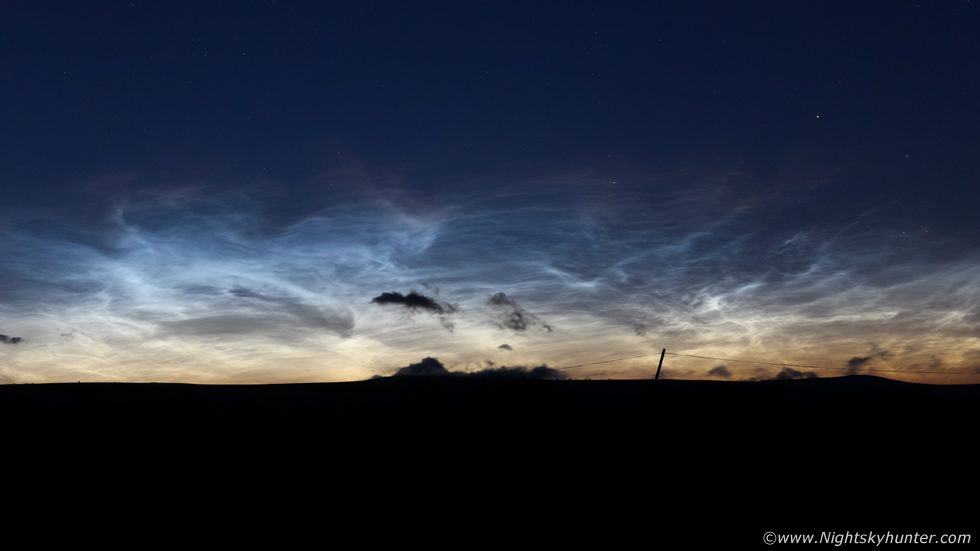 |
This is a great location with open landscape for shooting however there was no other foreground interest I could use for the images other than the tree so I just had to shoot across the top of the hills, I could do nothing about that single telegraph pole though. NLCs need a good horizon and the best NLC images should have some kind of subject in the frame, keep it simple, a single subject or even a lake reflecting the sky is always a winner. I've become very fussy in recent years about my night sky and storm photography, I really don't like cluttered scenes and try my best to keep the sky the dominating feature with no distracting elements if possible.
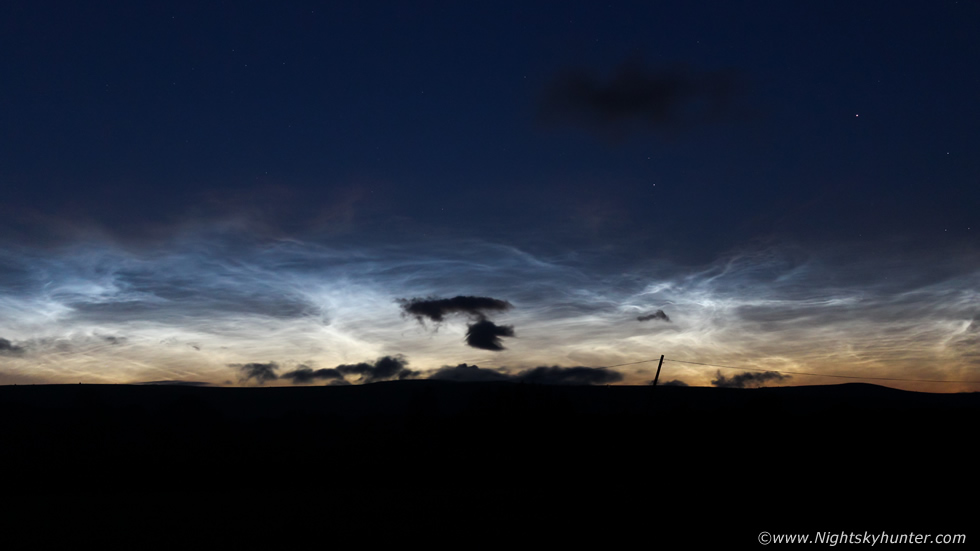 |
This was the darkest part of the night, I could actually see an extremely well defined twilight arch extending from NW, N to NE, outside of that the sky was remarkably dark for mid July. The Milky Way was faintly visible including M31 while to the north the sky was literally lit up with Noctilucent Clouds. Jonathan and I were commenting on various constellations, the Milky Way structure, passing satellites and a bright ISS pass. Look carefully at this image and the next couple at the top of the NLCs, can you make out a reddish colour?, I will get to that in a moment.
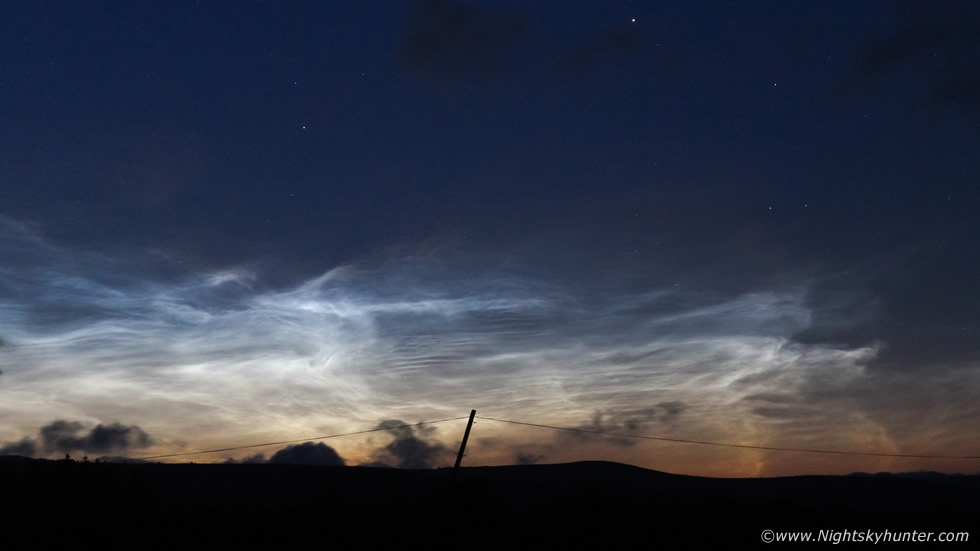 |
The structure to the right looked like a running man with two ungainly legs to the naked eye. There's a broad range of structure in this image in the form of herringbone/waves, medium scale whirls, soft and hard bands and striking knots.
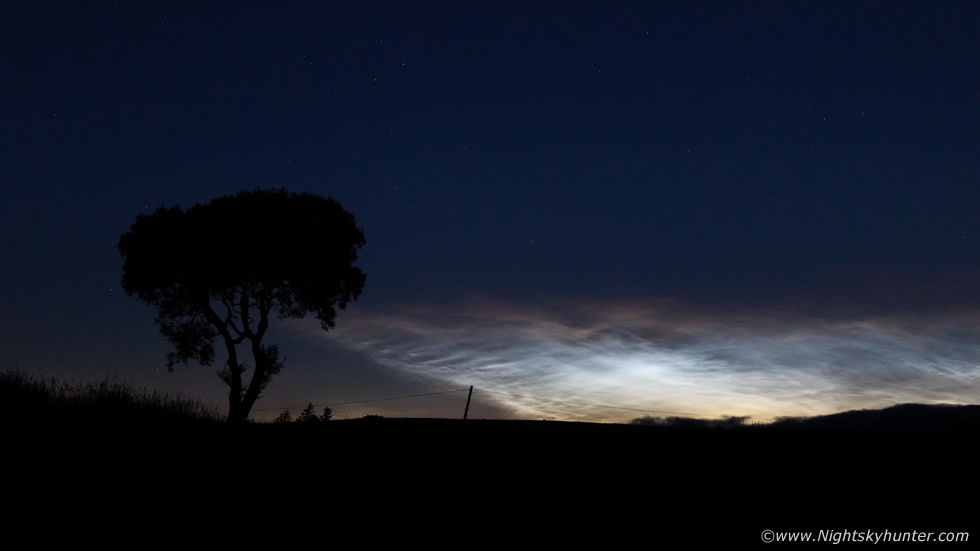 |
Late in the night when the sun was at it's lowest elevation the NLCs dropped low to the horizon but their intensity remained striking. To me the shape on the left looked like the anvil on a distant thunderstorm with 'mammatus' with a well defined sharp edge. However what shocked me was the red colours at the top of the clouds, these are considered more rare, I normally observe them once every season, sometimes none at all, but on this occasion the colour was actually very obvious to the naked eye, perhaps because of the dark sky background which aided with contrast. It was a strange dark red, not dissimilar to an oak red wine or even the bizarre dark red beams one can see in certain aurora displays. The camera shows it as a combination of red and brown, I mentioned this to Jonathan and he could see it too, I once again began shooting a time lapse of this cool eerie scene. The following is from a spaceweather.com article about this very phenomena...
To understand what makes NLCs red, first we have to ask What makes them blue? The answer is ozone. Research in the 1970s revealed that much of the sunlight hitting noctilucent clouds first passes through Earth’s ozone layer. Ozone absorbs red light, while allowing blue to pass. This filtered light gives NLCs an azure hue.
The origin of red is less certain. One idea, probably the best, comes from a 1988 paper in the Journal of Atmospheric and Terrestrial Physics entitled “The coloured edge of noctilucent clouds.” The authors note that “Noctilucent clouds are illuminated by sunlight which passes obliquely through the atmosphere. The lowest rays may pass only a few kilometres above sea level.” These low rays are strongly reddened (like sunsets) and bent by refraction; some of them may be redirected to the tops of NLCs. Is that right? Even many specialists in NLC research aren’t sure, which means every sighting is a bit of a mystery.
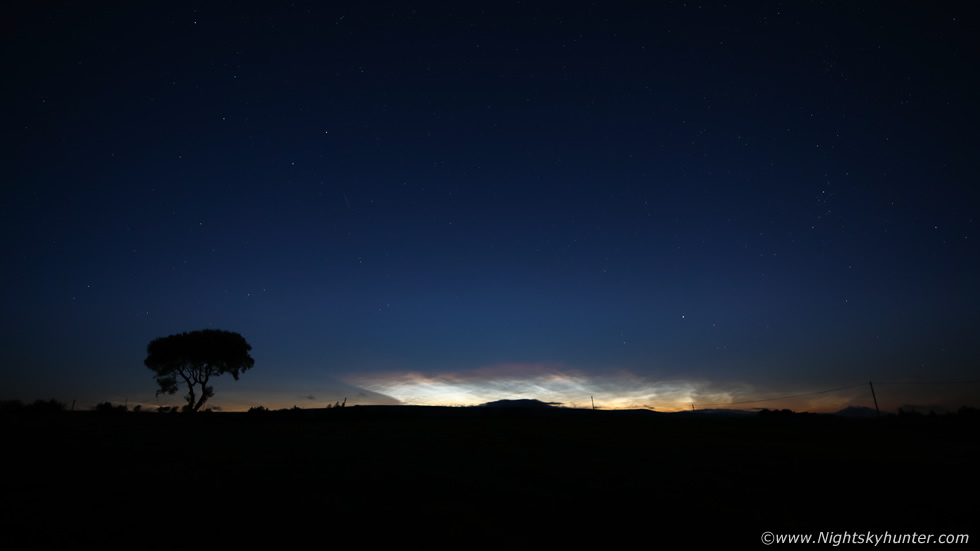 |
Super wide angle image at 15mm, something I rarely do with low elevation NLCs but I wanted to capture the twilight arch, dark sky above, and the stars for a sense of scale, you can also see the red colour quite vividly. The NLCs then reduced in magnitude and the structure became softer so I decided to call it a night as I had seen the best of it, the time was 02.00 BST. At the time of writing this was the best NLC display of the 2021 season, however I'm still hopeful of another surprise show yet and now that the nights are getting darker it won't be long to the Perseids and perhaps, touch wood, our first aurora displays in a very long time, the sun is now getting active, but more on this later.
Time lapse of the Beaghmore NLC display shot with a crop sensor Canon 600D with 18-55mm lens and full frame Canon 5D Mark IV with 15mm prime lens. I really wish I had shot more frames to get a longer lapse but I at least got something for the record, a fantasic rewarding night, thanks very much for reading.
Martin McKenna